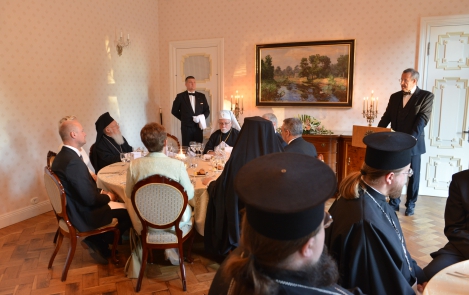-
Reset
+


President Ilves to Patriarch Bartholomew: only in a free and democratic country can we believe without fear and stand for our convictions without apprehension
05.09.2013
"Thank you for the determination and perseverance you have shown in attempting to break down the artificial walls between people and communities and in bridging hearts," told the President, Toomas Hendrik Ilves, at an official dinner held to honour the Archbishop of Constantinople, New Rome, and Ecumenical Patriarch Bartholomew.
The Estonian Head of State thanked the Patriarch for the support he had offered in restoring the autonomy of the Orthodox Church of Estonia by reactivating the Tomos on 20 February 1996.
"We have the pleasure of hosting you in a contemporary Estonia that is free, democratic and open. Our success and rapid development are not accidental but are built upon the basic values of society – honesty, diligence, responsibility and perseverance. As well as faith," President Ilves confirmed.
The Estonian people have been less eager than some other nations to connect themselves officially to churches, largely due to our mixed and sometimes painful historical experiences, admitted the Head of State, saying that our faith lives, above all, in our hearts and the peaceful co-existence of different faiths and creeds has always been one of the pre-requisites for Estonia's survival.
"We have always needed both faith and tolerance to cultivate our Nordic, windward country. The freedom of religion is one of the corner stones of our values and laws. The Estonian Declaration of Independence, also known as the Manifesto to the Peoples of Estonia, proclaimed on 24 February 1918 in Tallinn, declared freedom to all citizens, regardless of their religious or political views and nationality. For the Republic of Estonia, this was the only form of existence considered possible," told President Ilves.
The history of the Orthodox Church of Estonia is closely intertwined with the development of the Republic of Estonia, including their most tragic moments. One of the most memorable players in our shared story is Platon, who was ordained as Bishop of the Estonian Diocese of the Orthodox Church just before Estonia proclaimed its independence, and he was a committed supporter of the Republic of Estonia who also took part in the Estonian Diet (the Estonian Provincial Assembly). In January 1919, the Bolsheviks who invaded Tartu imprisoned, tortured and murdered him along with 18 other dignified citizens, the list of victims including both Orthodox priests and Lutheran pastors.
"The martyr's death was discovered only some days later and shocked the society but it also showed Estonia that only in an independent, free and democratic country can we believe without fear and stand for our convictions without apprehension, thereby shaping our own future. We established our own state," recalled the Estonian Head of State.
He concluded by quoting the consecration by Martyr Bishop Platon of 21 December 1918, the day that the Bolsheviks who invaded Tartu hoisted a red flag on the tower of the Town Hall building: "...differences between the various denominations are nothing else than walls built by men, while high above these walls God sits enthroned ..."
Office of the President
Public Relations Department
Phone +372 631 6229




